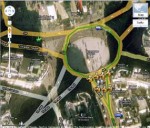 Some professional protesters may have better and fresher intel than the police
Some professional protesters may have better and fresher intel than the police
For some, anarchy is a full-time job. The nature or cause of the event is a far secondary issue to the opportunity to disrupt people’s lives, destroy property, and flip the bird at authority. These folks devote their talents to devising new ways of creating quickly-constructed blockades of streets and buildings, improvising protective gear, and manufacturing weapons to use against riot police. Organizations such as the Direct Action Network, which played a major role in the 1999 “Battle in Seattle” riots, provide instrumentality for the riot-inclined. Fortunately, anarchists don’t organize well (imagine that), so the networks come and go.
These professional anarchists travel the globe to lend their skills at whatever demonstration might be handy, ranging from World Trade Organization meetings to student protests like London is experiencing. Like most other major cities, London has its share of organized protest demonstrations from time to time. Most recently, the Metropolitan Police contended with multiple incidents centered on the news that tuition at public universities was being increased substantially. The latest protests may have been the first instance of social networking used not just to organize the protests, but also to monitor activity in real time and subvert police efforts to keep the peace.
In December 2010, protest organizers used custom Google Maps to track police movements and rally points, updating the maps in real time with wireless Internet connections. The updaters even created custom icons to represent police, aircraft, and prisoner transport vans. Google Maps can be shared between designated users or made public, so anyone who knows where to look can see it. The maps for this event were public, and presumably the links to them were disseminated to other protest information sources.
Historically, police have had the upper hand in tactical information during public order events. Radio networks of officers posted at observation points, possibly coupled with closed-circuit television images, keep command post personnel apprised of what’s happening and where. Keeping that information current is absolutely critical for effective management of the situation. Without it, personnel and equipment won’t be where it’s most needed.
The proliferation of highly capable handheld ‘smartphones’ now makes it easy for protest organizers to communicate by voice, text and images, even with real-time video. The protesters may have more watchers and observation points than the police, and actually outpace the police in quantity and quality of intelligence.
Having this kind of information available has made it possible for disrupters to create decoy incidents to draw resources away from where they are needed most. An observation point may report that people are assembling a “protest tripod” to block an intersection at ‘X’ and ‘Y’ streets. These tripods are made of three tall poles, lashed together at one end with a protester dangling from the junction. They take up a lot of room and are difficult to dismantle quickly without injuring the protester. Meanwhile, there is a less obvious gathering of people in another location who intend to break out windows and tip over cars on a street as soon as forces are marshaled to intercept the tripod crew.
Having a real-time map, complete with satellite photos, of where everyone is at any one moment is almost as good as having your own helicopter overhead — maybe better, if you can distract the crew of the helicopter.
First Amendment and net neutrality issues being what they are, there isn’t much law enforcement can do to keep protest organizers from using these resources. What you can do is know that your opposition has access to this kind and quality of information, and not to underestimate them or their capability. Managing large-scale public order incidents is a science, and it’s possible to leverage a relatively small force to be effective against a large gathering. If you anticipate the possibility of a protest or other anarchist demonstration in your community, prepare now.
The protesters are preparing already.
Source: http://www.policeone.com/police-technology/articles/3115790-Rioters-using-Google-Maps-for-real-time-information/
